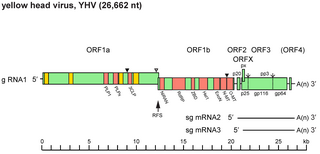
Okavirus is a genus of enveloped positive-strand RNA viruses which infect crustaceans. Host organisms are mostly shrimp. It is the only genus in the family Roniviridae. Viruses associated with the genus include: gill-associated virus (GAV) which causes reddening, biofouling with exoparasites, emaciation, and massive mortality; and yellow head virus (YHV) which causes yellow head, arrest of feeding, and massive mortality. The name is derived from the 'Oka' or lymphoid organ in which the viruses are commonly detected and in which pathology occurs during acute infections. Lymphoid organs are anatomical structures common to penaeid shrimp. There are three species in this genus.
Amdoparvovirus is a genus of viruses in the family Parvoviridae in the subfamily Parvovirinae. Mustelids, skunk, and raccoons serve as natural hosts. There are five species in this genus. Diseases associated with this genus include progressive disorder of immune system.

Erythroparvovirus is a genus of viruses in subfamily Parvovirinae of the virus family Parvoviridae. Primates serve as natural hosts. There are seven species in this genus. Diseases associated with this genus include fifth disease and skin lesions.
Bocaparvovirus is a genus of viruses in the subfamily Parvovirinae of the virus family Parvoviridae. Humans, cattle, and dogs serve as natural hosts. There are 28 species in this genus. Diseases associated with this genus include, in humans, acute respiratory illness, and in cattle, diarrhea and mild respiratory symptoms.
Densovirinae is a subfamily of single-stranded DNA viruses in the family Parvoviridae. The subfamily has 11 recognized genera and 21 species. Densoviruses are known to infect members of insect orders Blattodea, Diptera, Hemiptera, Hymenoptera, Lepidoptera, and Orthoptera, while some viruses infect and multiply in crustaceans such as shrimp or crayfish, or sea stars from phylum Echinodermata.
Betapapillomavirus is a genus of viruses, in the family Papillomaviridae. Human serve as natural hosts. There are six species in this genus. Diseases associated with this genus include warts, papilloma, and malignant tumours.
Brevihamaparvovirus is a genus of viruses in subfamily Hamaparvovirinae of the family Parvoviridae. Mosquitoes serve as natural hosts. There are two species in this genus.

Caulimovirus is a genus of viruses, in the family Caulimoviridae order Ortervirales. Plants serve as natural hosts. There are 12 species in this genus. Diseases associated with this genus include: vein-clearing or banding mosaic.
Epsilonpapillomavirus is a genus of viruses, in the family Papillomaviridae. Cattle serve as natural hosts and it is one of the bovine papillomaviruses. There are two species in this genus. Diseases associated with this genus include: fibropapillomas and true epithelial papillomas of the skin.
Etapapillomavirus is a genus of viruses, in the family Papillomaviridae. Birds serve as natural hosts. There is only one species in this genus: Etapapillomavirus 1. Diseases associated with this genus include: causes cutaneous lesions.
Iotapapillomavirus is a genus of viruses, in the family Papillomaviridae. Rodents serve as natural hosts. There are two species in this genus. Diseases associated with this genus include: cutaneous lesions and benign skin tumours, such as papillomas and keratoacanthomas.
Iteradensovirus is a genus of viruses in the subfamily Densovirinae of the family Parvoviridae. Insects serve as natural hosts. There are five species in this genus.
Lambdapapillomavirus is a genus of viruses, in the family Papillomaviridae. Cats and dogs serve as natural hosts. There are five species in this genus. Diseases associated with this genus include: mucosal and cutaneous lesions.
Nupapillomavirus is a genus of viruses, in the family Papillomaviridae. Humans serve as natural hosts. There is only one species in this genus: Nupapillomavirus 1. Diseases associated with this genus include: facial warts. It has also been detected in some skin carcinomas and premalignant keratoses.
Omikronpapillomavirus is a genus of viruses, in the family Papillomaviridae. Porpoises serve as natural hosts. There is only one species in this genus: Omikronpapillomavirus 1. Diseases associated with this genus include: causes genital warts.
Thetapapillomavirus is a genus of viruses, in the family Papillomaviridae. Birds serve as natural hosts. There is only one species in this genus: Thetapapillomavirus 1. Diseases associated with this genus include cutaneous lesions.
Zetapapillomavirus is a genus of viruses, in the family Papillomaviridae. Horses serve as natural hosts. There is only one species in this genus: Zetapapillomavirus 1. Diseases associated with this genus include: cutaneous lesions.
Aveparvovirus is a genus of viruses, in the subfamily Parvovirinae of the virus family Parvoviridae. There are three species in this genus. Diseases associated with this genus include: enteric disease and malabsorption syndrome.
Copiparvovirus is a genus of viruses in subfamily Parvovirinae of the virus family Parvoviridae. Pigs and cows are known to serve as natural hosts. There are seven species in this genus.
Hepanhamaparvovirus is a genus of viruses that belongs to the Hapanhamavirinae subfamily of the family Parvoviridae. Insects and shrimps serve as natural hosts. Infection leads to mortality in the early larval and postlarval stages of the shrimp. There is only one species in this genus: Decapod hepanhamaparvovirus 1.


